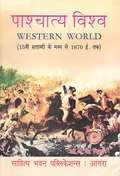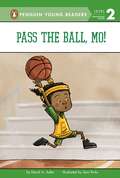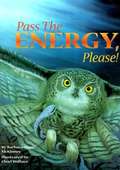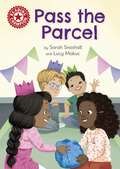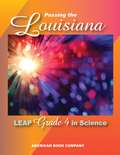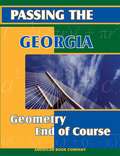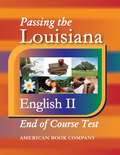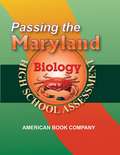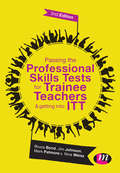- Table View
- List View
Pashchatya Vishwa (15vi shtabdi ke madhya se 1870 tak) F.Y.B.A. M.P. University
by A. K. Mittal R. Agarwalपाश्चात्य विश्व 15वीं शताब्दी के मध्य से 1870ई. तक Western World Book मध्य प्रदेश के विभिन्न विश्वविद्यालयों में बी.ए. (इतिहास) प्रथम वर्ष के द्वितीय प्रश्न-पत्र के लिए निर्धारित नए वार्षिक पद्धाति के अनुसार पाठ्यक्रम पर आधारित है। नवीनतम् जानकारी व सरल भाषा होने के साथ-साथ पुस्तक में स्पष्ट मानचित्रा (Maps) व तालिकाआ (Charts) के द्वारा क्लिष्ट विषयों को भी विद्यार्थियों को समझने के अनुकूल बनाया गया है। पुस्तक पूर्णतया नवीन पाठ्यक्रम के अनुरूप है। प्रत्येक अध्याय से सम्बन्धित लघु एवं वस्तुनिष्ठ प्रश्न भी दिए गये हैं।
Pashchimatya Rajakiy Vichar 1 Paper 1 SYBA Third Semester - SPPU: पाश्चिमात्य राजकीय विचार १ पेपर १ एस.वाय.बी.ए. सेमिस्टर ३ - सावित्रीबाई फुले पुणे यूनिवर्सिटी
by Prof. Pramod Rajendra Tambeएस.वाय.बी.ए. राज्यशास्त्र विशेष स्तरावरील शैक्षणिक वर्ष 2020-21 च्या CBCS पॅटर्नच्या (DISCIPLINE SPECIFIC ELECTIUE COURSE) (DSE-1A(3)) म्हणून 'पाश्चात्य राजकीय विचार' चे सत्र - 3 साठी अध्यापन केले जाणार आहे. राजकीय विचारांचे अवकाश पाश्चात्य विचारांशिवाय अपूर्णच राहते. पाश्चिमात्य राजकीय विचारवंतांनी राजशास्त्राला अनेक राजकीय संकल्पनांची, सिद्धान्तांची, विचारप्रणालीची देणगी दिली आहे. त्यांनी सामाजिक-राजकीय समस्या सोडविण्यासाठी मांडलेले विचार आजही जगभरात अभ्यासले जातात. या अभ्यासक्रमाच्या सत्र तीनमध्ये आपण चार विचारवंत अभ्यासणार आहोत. त्यात प्रथम प्लेटो हा ग्रीक विचारवंत आहे. याच्या आदर्श राज्य, शिक्षणाचा दृष्टिकोन व न्यायाचा सिद्धान्त या तीन संकल्पनांचा अभ्यास करणार आहोत. दुसरा, ॲरिस्टॉटल हा सुद्धा ग्रीक विचारवंत आहे. याच्या ‘राज्यांचे वर्गीकरण', 'गुलामगिरी विषयक विचार' व क्रांतीच्या सिद्धान्ताचा अभ्यास करणार आहोत. तिसरा मॅकियाटहेली हा इटलीचा पंधराव्या शतकातील विचारवंत असून याच्या मानवी स्वभाव, धर्म आणि नैतिकतेसंबंधी विचार व राज्यविषयक विचारांचा अभ्यास करणार आहोत. चौथा, जॉन लॉक हा सतराव्या शतकातील इंग्लंडचा विचारवंत असून याच्या ‘राज्याचे स्वरूप', 'नैसर्गिक हक्क' व 'सामाजिक कराराचा सिद्धान्त' यांचा अभ्यास/अध्ययन करणार आहोत.
Pashchimatya Rajakiy Vichar 2 Paper 1 SYBA Fourth Semester - SPPU: पाश्चिमात्य राजकीय विचार २ पेपर १ एस.वाय.बी.ए. सेमिस्टर ४ - सावित्रीबाई फुले पुणे यूनिवर्सिटी
by Pramod Sharda Rajendra Tambe Omkar Nirmala Ankush Koravle Vikas Lalita Tejerao Waghmareशैक्षणिक वर्ष 2020-21 च्या (CBCS) पॅटर्नप्रमाणे एस.वाय.बी.ए. राज्यशास्त्र विशेष स्तरावरील (Discipline Specific Efective Course) (DSE - 1BC3) म्हणून, 'पाश्चिमात्य राजकीय विचार' या विषयाचा सत्र 4 साठी अभ्यासक्रमात समावेश करण्यात आला आहे. या अभ्यासक्रमानुसार सत्र चारमध्ये आपण चार विचारवंत अभ्यासणार आहोत. यात प्रकरण 1 मध्ये रूसो यांच्या राज्याचा स्वभाव, सामूहिक ईहा व सामाजिक कराराचा सिद्धान्त यांचा अभ्यास करणार आहोत. प्रकरण 2 मध्ये हेगेल यांच्या आदर्शवाद, राज्यांचा सिद्धान्त आणि स्वातंत्र्यावरील त्यांचे विचार या उपघटकांचा अभ्यास करणार आहोत. प्रकरण 3 मध्ये जॉन स्टुअर्ट मिल यांच्या स्वातंत्र्यविषयक विचार, प्रातिनिधिक शासन आणि उपयुक्ततावादावरील विचार यांचा अभ्यास करणार आहोत. प्रकरण 4 मध्ये कार्ल मार्क्स यांच्या ऐतिहासिक भौतिकवाद वर्गसंघर्ष, राज्य आणि क्रांतीचा सिद्धान्त या उपघटकांचा अभ्यास करणार आहोत.
Pashchyatya Rajkiya Vichar Ani Adhunik Bhartiya Rajkiya Vichar Second Semester FYBA New NEP Syllabus - RTMNU: पश्च्यात्य राजकीय विचार अनी आधुनिक भारतीय राजकीय विचार द्वितीय सेमेस्टर FYBA नया NEP सिलेबस - RTMNU
by Prof. Dr. Rakshit Madan Bagdeया पुस्तकात ‘पर्यटन आणि आदरातिथ्य व्यवस्थापन कौशल्ये’ या विषयाची माहिती दिली आहे. यात पर्यटनाचा अर्थ, व्याख्या, स्वरूप आणि विविध प्रकारांविषयी मार्गदर्शन दिलेले आहे. पर्यटक, प्रवासी, अभ्यागत आणि पर्यटनाचे सामाजिक, सांस्कृतिक, आर्थिक आणि पर्यावरणीय परिणाम काय असतात याची माहिती यात समाविष्ट आहे. आदरातिथ्य व्यवस्थापनात ग्राहक सेवा, निवास, हॉटेल व्यवस्थापन, खाद्यपदार्थ, सुरक्षा आणि वितरण प्रणालीचे महत्त्व सांगितले आहे. पर्यटन आणि आदरातिथ्य क्षेत्रात यशस्वी होण्यासाठी आवश्यक उपाय आणि कौशल्ये यावर मार्गदर्शन दिलेले आहे, जेणेकरून विद्यार्थ्यांना या क्षेत्रात चांगले करिअर घडवता येईल.
Paso a Paso (Level #2)
by Myriam Met Richard S. Sayers Carol Eubanks WarginA Spanish learning textbook
Pass the Ball, Mo! (Mo Jackson #3)
by David A. AdlerThe third installment in this adorable Level 2 Geisel Award-winning series from a classroom favorite!Mo's latest obsession is basketball. He's determined to learn how to pass, but as the shortest member of the team, he can't seem to launch the ball high enough. Can Mo learn to pass in time to help his team win the big game? This Level 2 reader about a little African-American boy with a big passion for sports is a funny, motivational companion to the winner of the 2016 Theodor Seuss Geisel Award.Praise for Pass the Ball, Mo!:"...welcome addition to the easy reader shelves." --The Horn Book
Pass the Energy, Please!
by Barbara McKinneyNature's food chains are sometimes short (grass eaten by deer) and sometimes long (goldenrod eaten by caterpillar, eaten by spider, eaten by warbler, eaten by weasel, eaten by fox). Everyone is part of nature's fascinating circle of players.
Pass the Parcel: Independent Reading Red 2 (Reading Champion #516)
by Sarah SnashallThis story is part of Reading Champion, a series carefully linked to book bands to encourage independent reading skills, developed with Dr Sue Bodman and Glen Franklin of UCL Institute of Education (IOE)Pass the Parcel shows the game in action and the parcel being passed around the children. Who will unwrap the final layer, and what is inside?Reading Champion offers independent reading books for children to practise and reinforce their developing reading skills.Fantastic, original stories are accompanied by engaging artwork and a reading activity. Each book has been carefully graded so that it can be matched to a child's reading ability, encouraging reading for pleasure. Perfect for 4-5 year olds or those reading book band red 2.
Passage to Discoveries, Unit 2: Seeking the Unknown
by Wright Group/McGraw-HillNIMAC-sourced textbook
Passing The Louisiana LEAP Grade 4 in Science
by Michelle Gunter Emily PowellPrepare for the Louisiana LEAP Grade 4 in Science test
Passing the Georgia Geometry End of Course Test
by Erica Day Alan Fuqua Colleen PintozziPassing the Georgia Geometry End of Course Test will help you review and learn important concepts and skills related to high school mathematics. To help identify which areas are of great-est challenge for you, first take the diagnostic test, then complete the evaluation chart with your instructor in order to help you identify the chapters which require your careful attention.
Passing the Louisiana English II End-of- Course Test
by Rob HunterPrep for this important language arts test.
Passing the Maryland High School Assessment in Biology
by Liz Thompson Michelle GunterPassing the Maryland Biology High School Assessment will help students who are learning or reviewing Core learning goals for the Biology sections of the Maryland High School Assessment Test in Biology. The materials in this book are based on the biology assessment goals, expectations and indicators as published by the Maryland Department of Education.
Passing the Professional Skills Tests for Trainee Teachers and Getting into ITT
by Jim Johnson Bruce Bond Mr Mark Patmore Nina Weiss Geoff BarkerIf you are applying to teacher training in England, you must pass your Professional Skills Tests for Trainee Teachers before you can start your training.<P><P> This is your guide to how to prepare for, approach and succeed in the Professional Skills Tests for Trainee Teachers. It takes you through how the tests work and includes hints and tips on what to expect and how to respond. It offers clear and concise guidance on revision and examples of questions so you can prepare for the tests and pass.<P> Also included is essential information on teaching and schools, knowledge of which may help you pass the tests, and information on how to successfully apply to Initial Teacher Training (ITT) in England. <P> Written by authors who have written questions for the test themselves, and published by Learning Matters, this is your essential guide to the Professional Skills Tests for Trainee Teachers.<P> Bruce Bond has been involved in writing, editing, observing, reviewing and trialling the QTS Literacy Skills Tests for over 10 years. He has also been closely associated with the national development and evaluation of the Initial Teacher Training pilots in invidividual learning plans, mentoring, and teaching observation and practice. Bruce has over 30 years of experience teaching English and literacy in SEN, primary, secondary and further education sectors and is now an educational consultant and author of literacy assessments.<P> Jim Johnson is an Honorary Fellow of Nottingham Trent University where, until his retirement, he led the English team in the Department of Primary Education.<P> Mark Patmore was until recently a senior lecturer in mathematical education in the Department of Education at Nottingham Trent University. He is an Associate of the AlphaPlus Consultancy and has written for the QTS Numaracy Skills Test.<P> Nina Weiss has worked in education for over 30 years. Since 2008, she has been authoring and editing the QTS Literacy Skills Tests. Nina currently teaches English and adult literacy at City and Islington College and is an external examiner for teacher training courses at the University of Greenwich and the Institue of Education, London.
Passion and Purpose: How to Identify and Leverage the Powerful Patterns That Shape Your Work/Life
by Arthur F. Miller Jr. Marlys Hanson Merle E. HansonThis book is about innate motivation--the naturally endowed needs, drives or desires that motivate a person to some particular action or behavior. Many terms are used to describe this phenomenon. Giftedness, talents, motivated abilities, natural strengths, motivational patterns or passion and purpose are some of the most common. Regardless of the specific term used, all are intended to convey the fact that every time a person accomplishes something personally significant and enjoyable, he or she will inevitably repeat some or all of the aspects of his or her innate motivation. Over time, a consistent pattern emerges that, if recognized and understood, reveals the basis for fulfillment and productivity for that individual. This book presents the System of Identifying Motivated Abilities, (SIMA), a behavior-based assessment process designed to identify this unique but consistent pattern of your natural strengths. The outcome of this SIMA Assessment is a description of your vocationally sighnificant motivations--what you enjoy doing and feel you did well.
Passport Reading JourneysTM III, Student Anthology
by Voyager Expanded Learning L. P.NIMAC-sourced textbook
Passport Reading JourneysTM III, Student Book, Part A
by Voyager Expanded LearningNIMAC-sourced textbook
Passport Reading JourneysTM III, Student Book, Part B
by Voyager Expanded LearningNIMAC-sourced textbook
